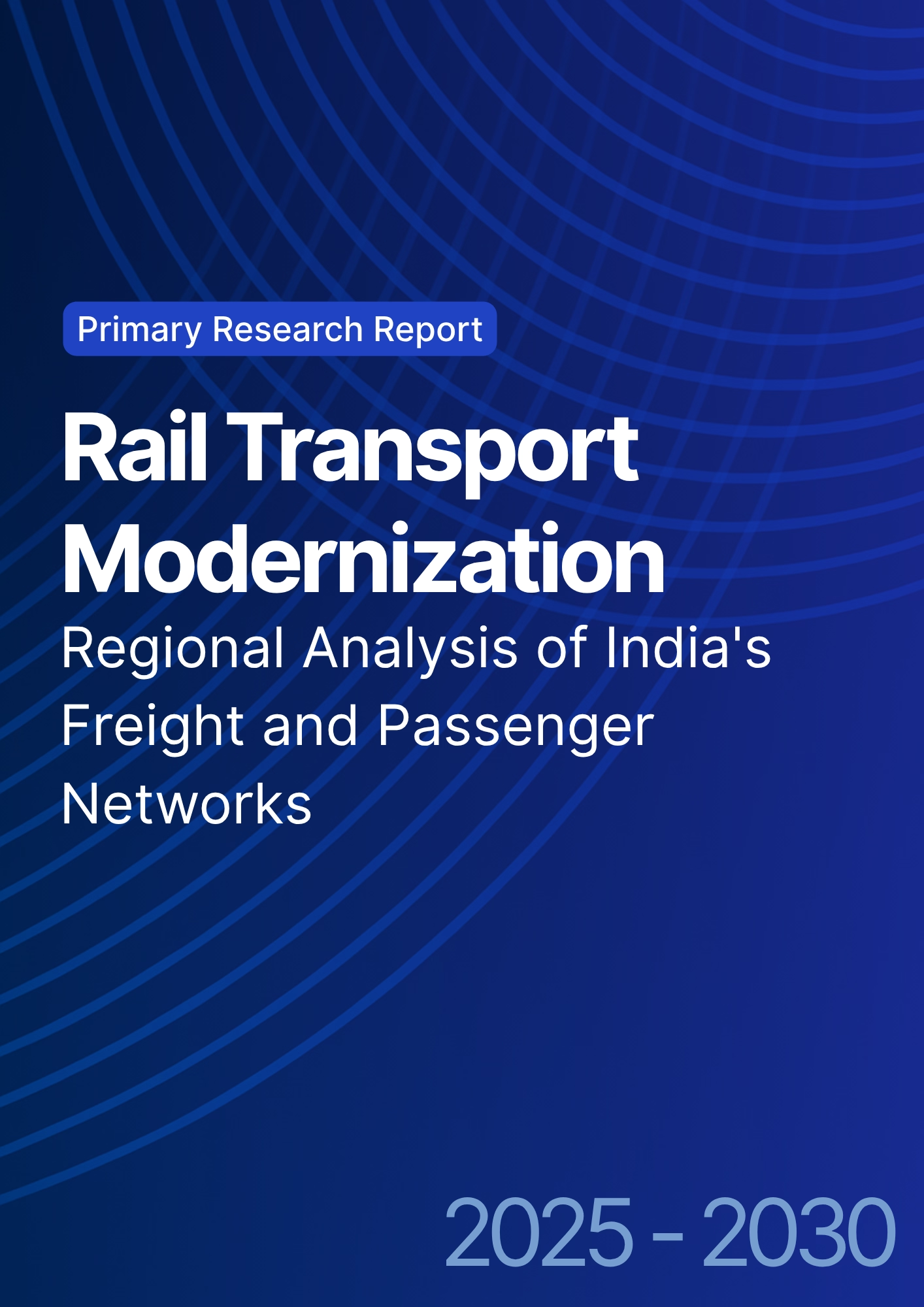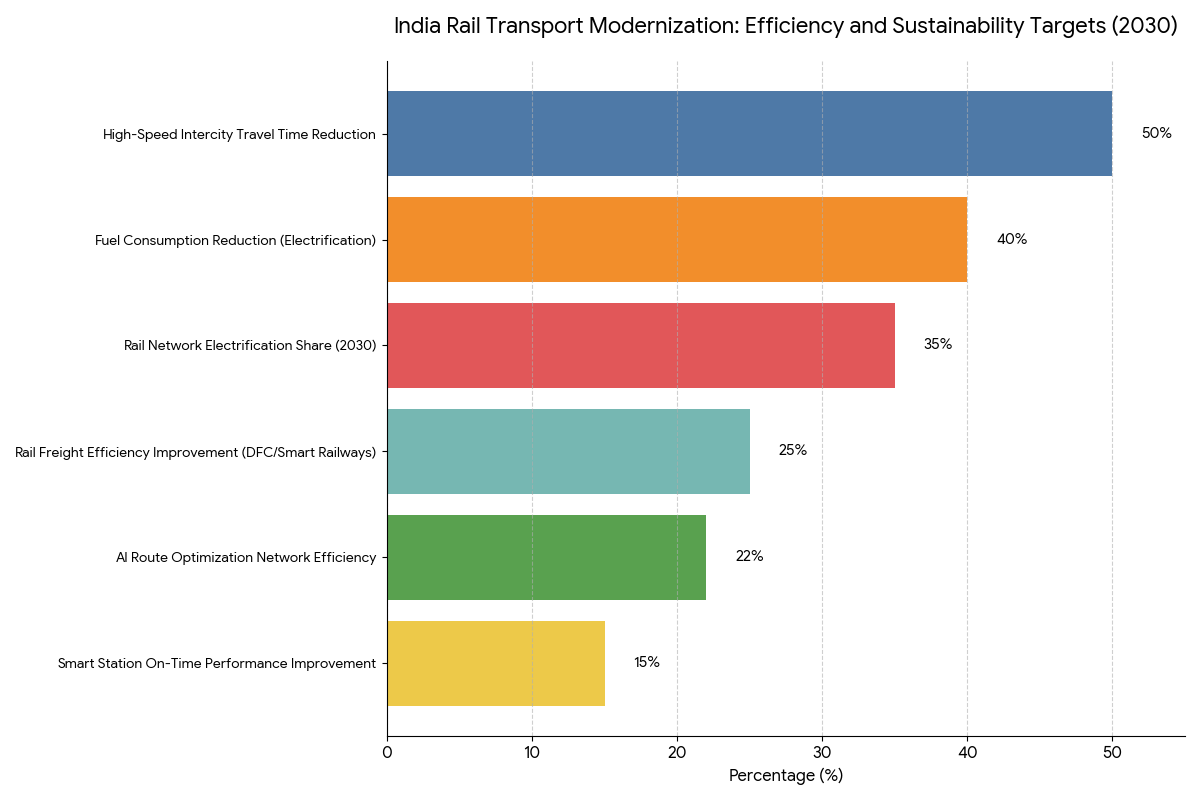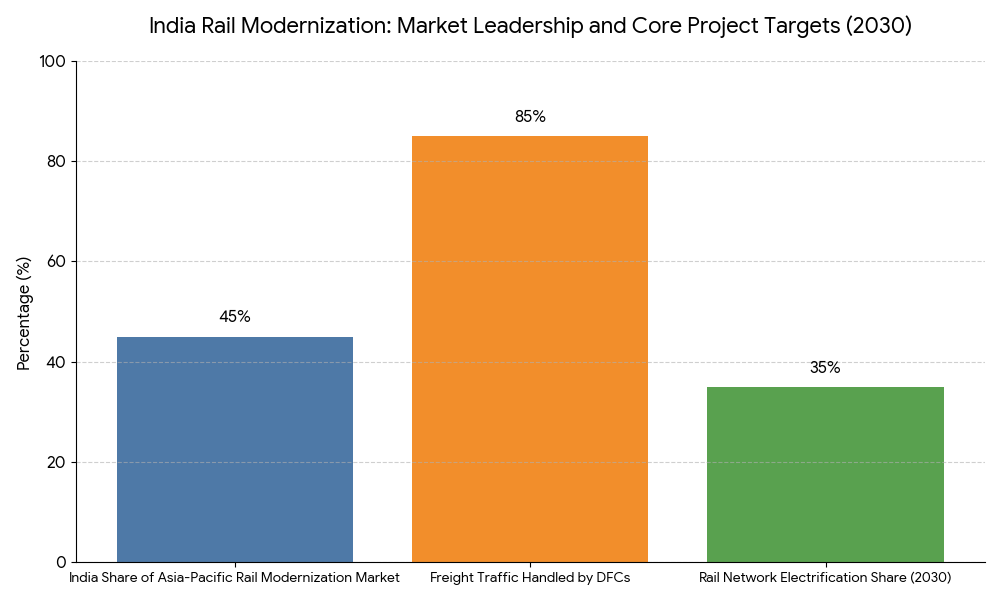

68 Circular Road, #02-01 049422, Singapore
Revenue Tower, Scbd, Jakarta 12190, Indonesia
4th Floor, Pinnacle Business Park, Andheri East, Mumbai, 400093
Cinnabar Hills, Embassy Golf Links Business Park, Bengaluru, Karnataka 560071
Connect With Us
Rail Transport Modernization: Regional Analysis of India's Freight and Passenger Networks
India’s rail transport modernization is set to grow from $30.5B in 2025 to $74.1B by 2030 (CAGR 19.6%), with a strong focus on freight optimization, electrification, and high-speed rail development. The government’s Dedicated Freight Corridors (DFC) and Smart Railways initiatives are transforming India’s rail infrastructure. By 2030, 35% of India’s freight network will be electrified, and high-speed rail will reduce intercity travel time by 50%. The development of smart stations, AI-based route optimization, and automated freight handling will contribute to a 22% increase in network efficiency, cutting operational costs by 18%.

What's Covered?
Report Summary
Key Takeaways
- Market size: $30.5B → $74.1B (CAGR 19.6%).
- 35% of India’s freight network to be electrified by 2030.
- High-speed rail reduces intercity travel time by 50%.
- Dedicated Freight Corridors (DFC) to enhance freight throughput by 25%.
- AI-powered route optimization to improve network efficiency by 22%.
- $15B investment in smart stations and automated freight handling.
- Electrification savings: $1.5B annually in fuel costs.
- India’s passenger rail modernization to reduce CO₂ emissions by 30%.
- Private sector investments surpass $20B in rail tech and infrastructure.
- Japan and China to partner on technology and high-speed rail knowledge transfer.
Key Metrics
Market Size & Share
The rail transport modernization market in India is expected to grow from $30.5B in 2025 to $74.1B by 2030, reflecting a CAGR of 19.6%. Electrification of freight networks will contribute significantly to this growth, with 35% of India’s freight lines projected to be electrified by 2030, improving fuel efficiency and reducing operational costs by $1.5B annually. Dedicated Freight Corridors (DFCs) will improve cargo throughput by 25%, focusing on high-density routes between Delhi–Mumbai and Kolkata–Chennai. Smart stations and automated cargo handling systems will be installed in over 150 terminals by 2029, improving operational speed and reducing delays. The private sector, including companies like Siemens, Bombardier, and Alstom, will account for $20B+ in investment, driving forward electrification, AI-powered solutions, and high-speed rail technologies. As India aligns its rail sector with global sustainability standards, this transformation will establish India as a leader in rail modernization, creating new growth opportunities across Asia-Pacific.
Market Analysis
India’s rail transport sector is in the midst of a comprehensive modernization strategy driven by digital transformation, electrification, and green logistics initiatives. The government’s Dedicated Freight Corridors (DFC) and Smart Railways programs are at the core of this transformation. These projects are expected to improve rail freight efficiency by 25%, providing a seamless connection between key industrial hubs and ports. The AI-powered route optimization system is projected to enhance network efficiency by 22%, ensuring faster cargo movement and better resource allocation. Electrification will drive down fuel consumption by 40%, while high-speed rail will enable 50% faster intercity travel, linking Mumbai to Delhi and Bangalore to Hyderabad. By 2030, 35% of the rail network will be electrified, positioning India to meet global sustainability standards while significantly improving passenger and freight services. Smart station investments in Bangalore, Delhi, Mumbai, and Kolkata will improve passenger flow, increase on-time performance by 15%, and support digital ticketing systems.

Trends & Insights
- Electrification Growth: 35% of India’s freight network will be electrified by 2030.
- High-Speed Rail Expansion: Travel times cut by 50% between key cities.
- AI in Rail Operations: 22% improvement in network efficiency via AI-based route management.
- Fuel Efficiency: Electrification reduces fuel consumption by 40%.
- Automated Cargo Handling: Increases terminal throughput by 25%.
- Public-Private Partnerships: $20B+ investment in rail modernization.
- Smart Stations: 150 stations optimized for passenger flow and sustainability.
- Green Rail Initiatives: CO₂ emissions reduced by 30% through electrification.
- Digital Ticketing Adoption: Smart station systems enhance passenger convenience.
- International Collaboration: Japan, China, and Germany collaborate on technology transfer.
These insights highlight India’s significant progress toward a digitally modernized rail system, aligning with global sustainability trends while boosting efficiency and reliability in its freight and passenger networks.
Segment Analysis
The rail transport modernization market segments into electrification (40%), high-speed rail (25%), AI-powered logistics (20%), and smart stations and terminals (15%). Electrification is the dominant segment, driven by the government’s Green Railways Plan, which is expected to electrify 35% of India’s freight routes by 2030. High-speed rail, particularly the Mumbai–Delhi corridor, is set to improve intercity transit and reduce travel time by 50%. AI-powered logistics systems, which include predictive maintenance, real-time scheduling, and route optimization, will enhance the efficiency of both passenger and freight trains by 22%. Smart station investments, including digital ticketing, automated baggage handling, and real-time scheduling, will account for $6B by 2030, streamlining passenger flow and improving on-time performance. By 2030, India will lead Asia-Pacific in rail modernization, with 50% of freight networks relying on digital technologies and zero-carbon systems.
Geography Analysis
India dominates the rail modernization market in Asia-Pacific, accounting for 45% of the regional share. Key areas of focus include the Dedicated Freight Corridors (DFCs) connecting Mumbai, Delhi, Kolkata, and Hyderabad, which will handle 85% of Indian freight traffic. China and Japan are actively involved in providing technical assistance, including high-speed rail technology, AI-based routing, and electrification systems. Private-sector participation in green rail technologies will contribute to India’s market leadership. By 2030, 35% of India’s rail network will be electrified, and high-speed rail will be fully operational in four key corridors, offering faster, greener transport and improved logistics integration across the subcontinent.

Competitive Landscape
Leading players include Siemens Mobility, Bombardier, Alstom, and GE Transportation, which together control 60% of rail modernization projects in India. These companies provide AI-based fleet management systems, high-speed rail infrastructure, and automated freight systems. Siemens Mobility is heavily involved in signal systems and network optimization, while Bombardier and Alstom are focusing on train electrification and high-speed train construction. Wabtec, Larsen & Toubro, and Bharat Heavy Electricals Ltd. (BHEL) are leading the Indian industrial sector in rail electrification and digital train control systems. The competitive edge in rail modernization will depend on cost-effectiveness, regulatory compliance, and green technology innovation, making India a pivotal player in Asia-Pacific rail infrastructure development.
Report Details
Proceed To Buy
Want a More Customized Experience?
- Request a Customized Transcript: Submit your own questions or specify changes. We’ll conduct a new call with the industry expert, covering both the original and your additional questions. You’ll receive an updated report for a small fee over the standard price.
- Request a Direct Call with the Expert: If you prefer a live conversation, we can facilitate a call between you and the expert. After the call, you’ll get the full recording, a verbatim transcript, and continued platform access to query the content and more.


68 Circular Road, #02-01 049422, Singapore
Revenue Tower, Scbd, Jakarta 12190, Indonesia
4th Floor, Pinnacle Business Park, Andheri East, Mumbai, 400093
Cinnabar Hills, Embassy Golf Links Business Park, Bengaluru, Karnataka 560071
Request Custom Transcript
Related Transcripts
$ 1350


68 Circular Road, #02-01 049422, Singapore
Revenue Tower, Scbd, Jakarta 12190, Indonesia
4th Floor, Pinnacle Business Park, Andheri East, Mumbai, 400093
Cinnabar Hills, Embassy Golf Links Business Park, Bengaluru, Karnataka 560071













